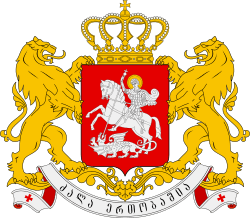Trialeti culture
| History of Georgia |
|---|
 |
|
History by topic |
|
|

The Trialeti culture (Georgian: თრიალეთის კულტურა, also known as Trialeti-Vanadzor [Kirovakan] culture), is named after the Trialeti region of Georgia. It is attributed to the late 3rd and early 2nd millennium BC.[1] Trialeti culture emerged in the areas of the preceding Kura-Araxes culture.[2]
Background
The earliest Shulaveri-Shomu culture existed in the area from 6000 to 4000 BC.[3] Then came the Kura-Araxes culture.
The flourishing stage of Trialeti culture began near the end of the third millennium BC.[4]
Kurgans
At that time, there was already strong social differentiation indicated by rich mound burials. There are parallels to the Early Kurgan culture. Cremation burial was practised. Painted pottery was introduced. Tin bronzes became predominant. Geographical interconnectedness and links with other areas of the Near East are seen in many aspects of the culture. For example, a cauldron found in Trialeti is nearly identical to the one from Shaft Grave 4 of Mycenae in Greece.[4]
The Trialeti culture shows close ties with the highly developed cultures of the ancient world, particularly with the Aegean,[5] but also with cultures to the south,[6] such as probably the Sumerians and their Akkadian conquerors.
Trialeti-Vanadzor painted monochrome and polychrome pottery is very similar to that in the other areas of the Near East. In particular, similar ceramics is known as the Urmia ware (named after Lake Urmia in Iran). Also, similar pottery was produced by the Uzarlik culture, and the Karmirberd-Sevan culture.
The site at Trialeti was originally excavated in 1936–1940 in advance of a hydroelectric scheme, when forty-six barrows were uncovered. A further six barrows were uncovered in 1959–1962.[7]
Related kurgans
Martqopi kurgans are somewhat similar, and are contemporary to the earliest among the Trialeti kurgans. Together, they represent the early stage of the Early Kurgan culture of Central Transcaucasia.
This Early Kurgan period, known as Martkopi-Bedeni, has been interpreted as a transitional phase and the first stage of the Middle Bronze Age.[8]
Burial practises
The Trialeti culture was known for its particular form of burial. The elite were interred in large, very rich burials under earth and stone mounds, which sometimes contained four-wheeled carts. Also there were many gold objects found in the graves.[5] These gold objects were similar to those found in Iran and Iraq.[3] They also worked tin and arsenic.[9] This form of burial in a tumulus or "kurgan", along with wheeled vehicles, is the same as that of the Kurgan culture which has been associated with the speakers of Proto-Indo-European. In fact, the black burnished pottery of especially early Trialeti kurgans is similar to Kura-Araxes pottery.[10] In a historical context, their impressive accumulation of wealth in burial kurgans, like that of other associated and nearby cultures with similar burial practices, is particularly noteworthy.[11] This practice was probably a result of influence from the older civilizations to the south in the Fertile Crescent.[12]
See also
References
- ↑ Munchaev 1994, p. 16; cf., Kushnareva and Chubinishvili 1963, pp. 16 ff.
- ↑ The Making of Bronze Age Eurasia - Page 266 by Philip L. Kohl
- 1 2 The Alekseev Manuscript - Chapter VII - Part II: Bronze Age in Eurasia
- 1 2 Joan Aruz, Sarah B. Graff, Yelena Rakic, Cultures in Contact: From Mesopotamia to the Mediterranean in the Second Millennium B.C. The Metropolitan Museum of art symposia. Metropolitan Museum of Art, 2013 ISBN 1588394751 p12
- 1 2 Trialeti culture
- ↑ Edens, Christoper (Aug–Nov 1995). "Transcaucasia at the End of the Early Bronze Age". Bulletin of the American Schools of Oriental Research. The American Schools of Oriental Research. 299/300 (The Archaeology of Empire in Ancient Anatolia): 60, 53–64. JSTOR 1357345.
- ↑ The Peoples of the Hills: Ancient Ararat and Caucasus. Charles Burney and David Marshall Lang p 90- 96.
- ↑ The Beginnings of Metallurgy
- ↑ Edens, page 56
- ↑ Edens page 58
- ↑ Edens page 59
- ↑ Edens, see generally
| Wikimedia Commons has media related to Archaeology of Trialeti. |
External links
- Middle Bronze Age, Trialeti Culture, South Caucasus - collection of articles at academia.edu
